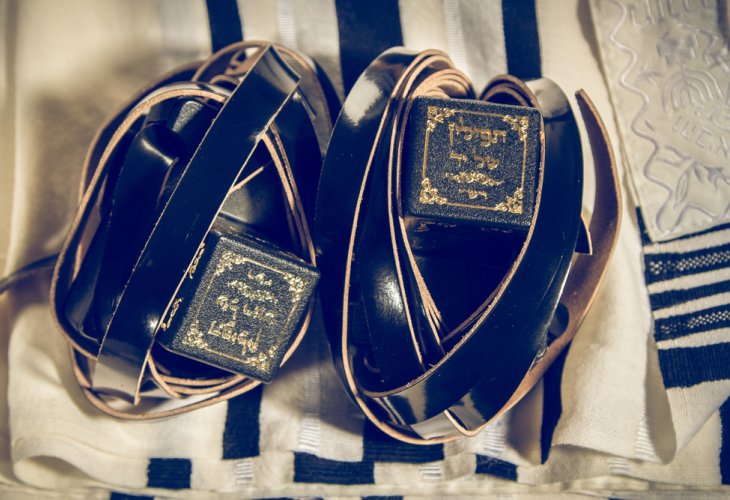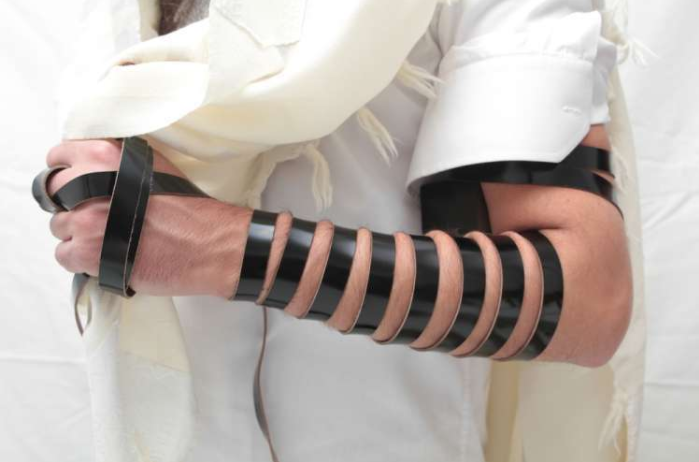Jewish Law
Why Are Tefillin Black? Hidden Light in Torah Tradition
Discover how layers of concealment reveal deep spiritual connection in this daily ritual practice
 (Photo: shutterstock)
(Photo: shutterstock)The Mitzvah of Binding Tefillin: Connecting Mind, Heart, and Faith
The essence of the mitzvah (commandment) of binding tefillin is connection — to tie, link, and secure the faith of the Jewish People to both the mind and the heart. This is done by binding the tefillin on the head, connecting to the mind, and on the arm, connecting to the heart. The act both physically and spiritually unites a person’s thoughts and emotions with the core belief: "Hear O Israel, Hashem our God, Hashem is One," which is written inside the tefillin. This declaration goes to the very essence of the Jewish soul.
Why Are Tefillin Black and Made of Animal Hide?
You might wonder: why are the tefillin black, with the sacred scrolls placed inside small compartments made of animal hide?
Rabbi Shimshon Pincus zt"l offers a beautiful explanation relating to the idea of a partition or barrier. Many people assume a partition creates separation or division, but more often, its true purpose is to enable connection.
For example, in a traditional synagogue, a partition separates men from women. This is done for reasons of modesty, to prevent mixing and enable people to focus on prayer and nothing else. Without this partition, either men or women would be excluded from the synagogue altogether. But due to the partition, women can come close enough to hear the sacred prayers and Torah readings. So paradoxically, the partition creates closeness and connection rather than distance.
The Divine Connection: Partitions at Mount Sinai
This concept of partitions aiding connection also applies to the giving of the Torah at Mount Sinai. The Torah tells us, "And Hashem descended upon Mount Sinai."
Now, consider this: the sun we know is one of the smallest “suns” in the universe according to the Talmud (Chullin 60). If the sun itself had descended on Mount Sinai, it would have incinerated the entire world.
So how could Hashem descend on Mount Sinai without destroying the world?
The answer lies in the partitions of darkness, cloud, and thick darkness described in the Torah. Through layers of concealment and protection, the Divine Presence was able to be revealed without overwhelming or destroying creation.
Rabbi Pincus explains that these partitions were not meant to distance or hide Hashem’s presence, but rather to reveal His royal glory and allow the Divine Presence to be received safely. Multiple layers of concealment actually make true connection possible.

How Tefillin Mirror This Divine Connection
This idea perfectly captures the essence of tefillin. The black color represents darkness and concealment; the compartments made of animal hide act as partitions that protect the wearer. There are three critical “partitions” in tefillin:
- The black color, symbolizing concealment
- The compartments (called battim—houses) that hold the sacred scrolls
- The animal hide, providing protection for the body
When we bind the Name of Hashem to the mind and heart, the soul would be overwhelmed by the intense holiness without these partitions. The protective layers allow Hashem's Name to be called upon us without causing the soul to depart from the body.
In other words, the tefillin let us connect deeply to Hashem’s unity and holiness while still living in the physical world. The partitions make it possible to sustain this intense spiritual connection without disconnecting from everyday life.
What If There Were No Partitions?
Imagine if tefillin were not black and not housed in protective compartments made of hide. Binding the holy Name directly to the mind and heart would create such intense clarity and spiritual attachment that all worldly concerns would immediately vanish.
A person would be unable to function in everyday life — much like Rabbi Shimon bar Yochai (see Talmud Shabbat 33), who was so spiritually elevated that his gaze burned up anyone engaging in mundane work as he did not understand how a person could concern himself with temporal matters and seemingly set aside, even temporarily, his attachment to eternal life.
The partitions in tefillin allow us to balance spiritual connection with worldly responsibilities, living a holy life within the physical world.

Why Don’t We Wear Tefillin on Shabbat?
Rabbi Pincus also explains why we don’t wear tefillin on Shabbat. Shabbat itself is a powerful spiritual connection to the Divine Presence — a kind of “shining tefillin” that illuminates truth fully, without the need for black compartments or partitions.
On Shabbat, every Jew becomes like Rabbi Shimon bar Yochai, whose Torah was his profession and who did not engage in ordinary worldly work at all. The Shabbat experience creates a complete spiritual rest and transforms the physical world into a glimpse of the World to Come.
Lessons from Tefillin for Shabbat and Daily Life
Finally, Rabbi Pincus teaches that just as tefillin must be bound with a permanent knot and one must maintain focus and not be distracted, so too must Shabbat be “bound” from evening to evening in a permanent, mindful way.
On Shabbat, one’s speech and behavior should reflect standing respectfully before the Divine King, without the distractions and casualness of weekday life.
Tefillin as a Bridge Between Worlds
The mitzvah of tefillin is a profound spiritual practice that connects Jewish heritage, faith, and identity. Through protective partitions, it balances intense holiness with daily life. This mitzvah invites us to bring the unity of Hashem into our minds and hearts, binding us to a living tradition that shapes both who we are and how we live.

